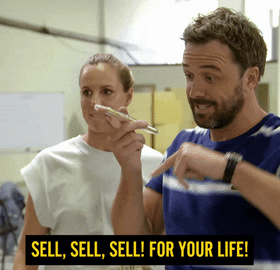Product Led Growth vs Sales Led Growth: Which One’s Right For You in 2023?
Product Led Growth vs Sales Led Growth: Which One’s Right For You in 2023?
Product Led Growth vs Sales Led Growth: Which One’s Right For You in 2023?
Dive into our detailed comparison on product led growth vs sales led growth to find out which one suits you best.
Dive into our detailed comparison on product led growth vs sales led growth to find out which one suits you best.
Dive into our detailed comparison on product led growth vs sales led growth to find out which one suits you best.



Product led growth vs sales led growth isn’t just an ongoing debate – it’s an intense showdown!
After all, your growth strategy impacts your product, customer experience, and sales process - basically EVERYTHING!
The success chronicles of companies like Zoom, Dropbox, and Canva, have made PLG the default growth strategy for modern SaaS organizations.
On the other hand, companies like Salesforce and Microsoft have kept the SLG boat afloat.
So what should be your go-to-market strategy to drive growth?

We get it. You’ve got boatloads to think about. 😫
But don’t get on the worry wagon just yet. We’ve got you covered!
In this article, we’re going to break down the key differences between product led growth (PLG) and sales led growth (SLG).
We’ll also take you through the product led sales strategy and a key tool that can help you rapidly experiment and ship out various go-to-market (GTM) motions at scale.
Let’s go!
Product Led Growth vs Sales Led Growth: Five Key Differences
Here’s a look at five crucial points of difference between product led growth and sales led growth:
1. Focus
PLG and SLG focus on two different aspects of your business. While one centers around the product 🎁, the other is all about the sales.💲
A. Product Led Growth:
PLG centers your product as the driving force for customer acquisition, retention, and monetization.
In a PLG company, this strategy doesn’t just extend to a product manager. All teams—from Engineering Blog to sales and marketing—treat the product as the main source of sustainable, scalable business growth.
This simply translates to the product being used and eventually “sold by itself, with limited sales intervention.”
This form of self-service happens when a PLG company removes all friction from the onboarding, product usage, and buying processes.
B. Sales Led Growth:
In a sales led company, the sales team is the driving force behind customer acquisition and retention.

This approach often follows the traditional marketing funnel where leads are qualified into marketing-qualified leads (MQLs) and sales-qualified leads (SQLs).
These SQLs are then passed to the sales team to nurture and convert.
Here, the sales team hopes to reach out to a potential customer and show them the product’s value to make a sale.
The catch?
Unlike a product led approach, users usually interact with the product only after they have had sales meetings and signed a contract.
2. Point of Contact
Product led growth is defined by a “freemium done right” strategy.
Through free trials and freemium pricing models, a product led company lets customers experience complete self-service (companies who enter enterprise sales may be more sales driven).
Customers sign up for a free trial, then decide to either upgrade to a premium plan or cancel their subscription. They have limited or no interaction with sales throughout this cycle.
Interestingly, 43% of B2B customers prefer a sales rep free product experience. So one thing your customers won’t be doing is this 👇

On the other hand, sales led growth involves the potential customer interacting with a sales rep or a customer success rep at EVERY stage of the buying journey.
3. Scalability
A product led company can scale with ease!
Its freemium pricing model gives it access to wider top-of-the-funnel opportunities.
Plus, PLG companies rely on customers to determine the product value. So they end up with a product qualified lead (PQL) that’s more likely to convert.
A sales led company, however, can experience logjams when it scales up too quickly. You’ll often hear the customer success teams saying…

Here’s why:
A sales led company scales up ➤ Leads pile up ➤ Adds stress on support and IT teams ➤ Results in a narrower top-of-the-funnel acquisition ➤ Leads to lost business.
Yikes!
4. Buying Cycle
A PLG strategy boasts a shorter sales cycle, thanks to the low entry barrier.
It relies on a great product experience to help users find value and move further down the sales funnel.
Usually, customers register an account, explore the product, and input their credit card information when ready to upgrade.

On the other hand, sales and marketing led growth companies typically have a long sales process.
This sales funnel includes qualification meetings, demos, customer feedback, objections, negotiation, contracts, customer training, and other complex requirements.
5. Customer Acquisition Cost (CAC)
With PLG companies, the freemium pricing model reduces the overall customer acquisition cost by serving as an acquisition strategy. This also means that the product team requires limited support from the sales teams.
What’s more?
Since users onboard themselves, a PLG strategy can shorten the sales cycle, resulting in higher revenue per employee (RPE).
Looks like:

A sales led approach, on the other hand, has to deal with increasing sales and marketing costs, resulting in a higher CAC. Additionally, a sales motion requires qualified professionals and freelancers, leading to higher operational costs.
This leads us to the all-important question.
Product Led vs Sales Led: Which One is Right For You?
Here’s one thing we can say for sure:
Both product led and sales led approaches play vital roles in revenue growth.
It’s impossible to say which approach is the best go-to-market (GTM) strategy for you, as it depends heavily on your product, target audience, and business model.
However, it’s important to note that product led growth isn’t here to replace sales or marketing.
Successful product led companies make the most of their product and their active user base while also leveraging other growth marketing and sales tactics.

Trust Loki on this one!
Product Led Sales: The Hybrid Solution For You
Product led strategies are the way to go for most SaaS companies. But these strategies can’t work in isolation and need assistance from sales.
Enter product led sales, a business model where the product and sales are strategic partners-in-crime!
Here’s what this would look like in action:
Let’s say a company implements a product led growth model with free trials or a freemium product. The product team can study the customer journey and user experience to improve the product.
The product management team will also focus on collaborating with other departments. As a result, the product manager is supported by a product marketing and sales team that jump in when needed.
And since the sales team can interact with the customers directly, it can continually share customer feedback with the product team and improve the product management and development processes.
A better product = improved value and user experience = increased customer retention = revenue growth = a win for everyone!
Most successful product led companies on the Forbes Cloud 100 list have customer success teams.
These teams realize that while PLG is the most effective way to widen top-of-funnel growth, sales can supercharge their growth by converting users to paying ones at the bottom-of-funnel.
They’ve cracked the code💡: Product led but sales powered!
Sounds great, right?
But there’s just one more hiccup…
How Do You Convert Freemium Customers to Paying Ones?
SaaS companies now have more existing customers than ever before! So the challenge isn’t customer acquisition anymore – it's conversion.
The solution?
Figuring out which customers are most likely to pay for the product and experimenting with various GTM strategies until you land on the ones that work.
How do you recognize the customers who’re most likely to convert?
And what growth strategy do you deploy for them?
This is where Toplyne comes into play!
Toplyne is a SaaS company that helps businesses and companies monetize their product led growth strategy.
With Toplyne, your business can automate the process of identifying promising leads and determine what GTM strategies will work best for each.
Here’s how companies like Canva and Vercel generate sales pipeline from their self-serve funnel using Toplyne:
Step 1/7: Create monetization playbooks to surface conversion and expansion opportunities (leads most likely to convert to paying customers, and teams most likely to grow into larger teams)

Step 2/7: Choose the right leads to target – users (individual users) or accounts (a group of users with an organization).

Step 3/7: Select the frequency at which you would want leads synced in your GTM apps.

Step 4/7: Define how many leads you want by either the number of leads or your expected win rate, depending on your sales capacity and GTM strategy.

Step 5/7: Build custom segments - Build custom segments based on And/Or logic at the deepest level of sub-properties within your product analytics.

Step 6/7: Validate your GTM strategy - Hold back some users as a control group to test your GTM strategy.

Step 7/7: Sync your product qualified pipeline into your GTM destinations - CRMs, sales & marketing execution tools, and customer engagement platforms.

Your empowered revenue team can now focus on users who show real intent rather than chasing leads that will never convert!

Product Led Growth vs Sales Led Growth: The Final Battle
Both product led and sales led growth strategies play key roles in revenue growth. So, it’s natural to wonder which one’s the perfect growth strategy for your SaaS company.
You can go through the differences highlighted in this article to get a clear picture. Ultimately, which boat sails and which one sinks depends on the nature of your product and your business model.
But one thing’s for sure – product led sales, the hybrid approach, is the real winner for most SaaS companies today!
And if you do pick this strategy, don’t forget to leverage Topylne to help you filter out high intent users that are most likely to convert to paying customers!
And of course, Toplyne has a freemium model 😉 So sign up for free today!
Product led growth vs sales led growth isn’t just an ongoing debate – it’s an intense showdown!
After all, your growth strategy impacts your product, customer experience, and sales process - basically EVERYTHING!
The success chronicles of companies like Zoom, Dropbox, and Canva, have made PLG the default growth strategy for modern SaaS organizations.
On the other hand, companies like Salesforce and Microsoft have kept the SLG boat afloat.
So what should be your go-to-market strategy to drive growth?

We get it. You’ve got boatloads to think about. 😫
But don’t get on the worry wagon just yet. We’ve got you covered!
In this article, we’re going to break down the key differences between product led growth (PLG) and sales led growth (SLG).
We’ll also take you through the product led sales strategy and a key tool that can help you rapidly experiment and ship out various go-to-market (GTM) motions at scale.
Let’s go!
Product Led Growth vs Sales Led Growth: Five Key Differences
Here’s a look at five crucial points of difference between product led growth and sales led growth:
1. Focus
PLG and SLG focus on two different aspects of your business. While one centers around the product 🎁, the other is all about the sales.💲
A. Product Led Growth:
PLG centers your product as the driving force for customer acquisition, retention, and monetization.
In a PLG company, this strategy doesn’t just extend to a product manager. All teams—from Engineering Blog to sales and marketing—treat the product as the main source of sustainable, scalable business growth.
This simply translates to the product being used and eventually “sold by itself, with limited sales intervention.”
This form of self-service happens when a PLG company removes all friction from the onboarding, product usage, and buying processes.
B. Sales Led Growth:
In a sales led company, the sales team is the driving force behind customer acquisition and retention.

This approach often follows the traditional marketing funnel where leads are qualified into marketing-qualified leads (MQLs) and sales-qualified leads (SQLs).
These SQLs are then passed to the sales team to nurture and convert.
Here, the sales team hopes to reach out to a potential customer and show them the product’s value to make a sale.
The catch?
Unlike a product led approach, users usually interact with the product only after they have had sales meetings and signed a contract.
2. Point of Contact
Product led growth is defined by a “freemium done right” strategy.
Through free trials and freemium pricing models, a product led company lets customers experience complete self-service (companies who enter enterprise sales may be more sales driven).
Customers sign up for a free trial, then decide to either upgrade to a premium plan or cancel their subscription. They have limited or no interaction with sales throughout this cycle.
Interestingly, 43% of B2B customers prefer a sales rep free product experience. So one thing your customers won’t be doing is this 👇

On the other hand, sales led growth involves the potential customer interacting with a sales rep or a customer success rep at EVERY stage of the buying journey.
3. Scalability
A product led company can scale with ease!
Its freemium pricing model gives it access to wider top-of-the-funnel opportunities.
Plus, PLG companies rely on customers to determine the product value. So they end up with a product qualified lead (PQL) that’s more likely to convert.
A sales led company, however, can experience logjams when it scales up too quickly. You’ll often hear the customer success teams saying…

Here’s why:
A sales led company scales up ➤ Leads pile up ➤ Adds stress on support and IT teams ➤ Results in a narrower top-of-the-funnel acquisition ➤ Leads to lost business.
Yikes!
4. Buying Cycle
A PLG strategy boasts a shorter sales cycle, thanks to the low entry barrier.
It relies on a great product experience to help users find value and move further down the sales funnel.
Usually, customers register an account, explore the product, and input their credit card information when ready to upgrade.

On the other hand, sales and marketing led growth companies typically have a long sales process.
This sales funnel includes qualification meetings, demos, customer feedback, objections, negotiation, contracts, customer training, and other complex requirements.
5. Customer Acquisition Cost (CAC)
With PLG companies, the freemium pricing model reduces the overall customer acquisition cost by serving as an acquisition strategy. This also means that the product team requires limited support from the sales teams.
What’s more?
Since users onboard themselves, a PLG strategy can shorten the sales cycle, resulting in higher revenue per employee (RPE).
Looks like:

A sales led approach, on the other hand, has to deal with increasing sales and marketing costs, resulting in a higher CAC. Additionally, a sales motion requires qualified professionals and freelancers, leading to higher operational costs.
This leads us to the all-important question.
Product Led vs Sales Led: Which One is Right For You?
Here’s one thing we can say for sure:
Both product led and sales led approaches play vital roles in revenue growth.
It’s impossible to say which approach is the best go-to-market (GTM) strategy for you, as it depends heavily on your product, target audience, and business model.
However, it’s important to note that product led growth isn’t here to replace sales or marketing.
Successful product led companies make the most of their product and their active user base while also leveraging other growth marketing and sales tactics.

Trust Loki on this one!
Product Led Sales: The Hybrid Solution For You
Product led strategies are the way to go for most SaaS companies. But these strategies can’t work in isolation and need assistance from sales.
Enter product led sales, a business model where the product and sales are strategic partners-in-crime!
Here’s what this would look like in action:
Let’s say a company implements a product led growth model with free trials or a freemium product. The product team can study the customer journey and user experience to improve the product.
The product management team will also focus on collaborating with other departments. As a result, the product manager is supported by a product marketing and sales team that jump in when needed.
And since the sales team can interact with the customers directly, it can continually share customer feedback with the product team and improve the product management and development processes.
A better product = improved value and user experience = increased customer retention = revenue growth = a win for everyone!
Most successful product led companies on the Forbes Cloud 100 list have customer success teams.
These teams realize that while PLG is the most effective way to widen top-of-funnel growth, sales can supercharge their growth by converting users to paying ones at the bottom-of-funnel.
They’ve cracked the code💡: Product led but sales powered!
Sounds great, right?
But there’s just one more hiccup…
How Do You Convert Freemium Customers to Paying Ones?
SaaS companies now have more existing customers than ever before! So the challenge isn’t customer acquisition anymore – it's conversion.
The solution?
Figuring out which customers are most likely to pay for the product and experimenting with various GTM strategies until you land on the ones that work.
How do you recognize the customers who’re most likely to convert?
And what growth strategy do you deploy for them?
This is where Toplyne comes into play!
Toplyne is a SaaS company that helps businesses and companies monetize their product led growth strategy.
With Toplyne, your business can automate the process of identifying promising leads and determine what GTM strategies will work best for each.
Here’s how companies like Canva and Vercel generate sales pipeline from their self-serve funnel using Toplyne:
Step 1/7: Create monetization playbooks to surface conversion and expansion opportunities (leads most likely to convert to paying customers, and teams most likely to grow into larger teams)

Step 2/7: Choose the right leads to target – users (individual users) or accounts (a group of users with an organization).

Step 3/7: Select the frequency at which you would want leads synced in your GTM apps.

Step 4/7: Define how many leads you want by either the number of leads or your expected win rate, depending on your sales capacity and GTM strategy.

Step 5/7: Build custom segments - Build custom segments based on And/Or logic at the deepest level of sub-properties within your product analytics.

Step 6/7: Validate your GTM strategy - Hold back some users as a control group to test your GTM strategy.

Step 7/7: Sync your product qualified pipeline into your GTM destinations - CRMs, sales & marketing execution tools, and customer engagement platforms.

Your empowered revenue team can now focus on users who show real intent rather than chasing leads that will never convert!

Product Led Growth vs Sales Led Growth: The Final Battle
Both product led and sales led growth strategies play key roles in revenue growth. So, it’s natural to wonder which one’s the perfect growth strategy for your SaaS company.
You can go through the differences highlighted in this article to get a clear picture. Ultimately, which boat sails and which one sinks depends on the nature of your product and your business model.
But one thing’s for sure – product led sales, the hybrid approach, is the real winner for most SaaS companies today!
And if you do pick this strategy, don’t forget to leverage Topylne to help you filter out high intent users that are most likely to convert to paying customers!
And of course, Toplyne has a freemium model 😉 So sign up for free today!
Related Articles




Behavioral Retargeting: A Game-Changer in the Cookieless Era
Unlock the power of behavioral retargeting for the cookieless future! Learn how it personalizes ads & boosts conversions. #behavioralretargeting




All of Toplyne's 40+ Badges in the G2 Spring Reports
Our customers awarded us 40+ badges in G2's Summer Report 2024.




Unlocking the Full Potential of Google PMax Campaigns: Mastering Audience Selection to Double Your ROAS
Copyright © Toplyne Labs PTE Ltd. 2024
Copyright © Toplyne Labs PTE Ltd. 2024
Copyright © Toplyne Labs PTE Ltd. 2024
Copyright © Toplyne Labs PTE Ltd. 2024